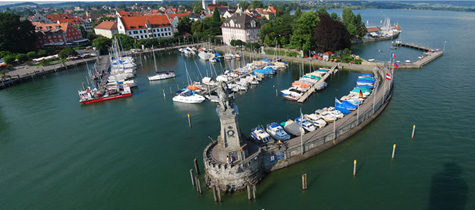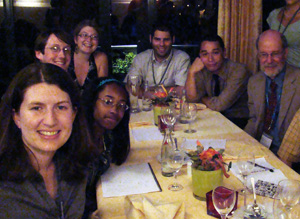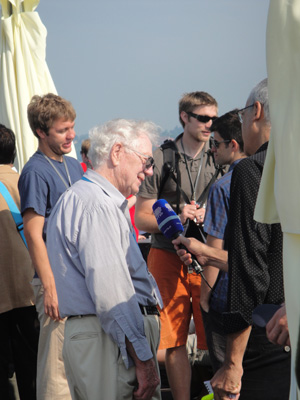
Chris Evans
Lindau Harbor, photographed by Chris Evans, a previous student attendee of the Lindau Nobel Laureate Meeting.
As scientific conferences go, the Lindau Meeting isn’t bad. The participants travel to Germany’s Lindau Island in Lake Constance at the foot of the Alps, where Nobel laureates have convened to inspire and enlighten them.
This summer, two Washington University students, Claire Cobley and Eric Feczko, were among the 75 American students selected by nationwide competition to attend the laureate’s gathering.
Cobley, a graduate student in the lab of Younan Xia, PhD, the James M. McKelvey Professor of Biomedical Engineering in the School of Engineering & Applied Science, is working on the development of nanoscale materials with medical applications.
Feczko, a graduate student in the neurosciences program, works with John Pruett, PhD, assistant professor of psychiatry in the School of Medicine, on autism and face recognition.
The Lindau meeting dates from 1951, when two physicians convinced Count Lennart Bernadotte of Wisborg to support a meeting of Nobel laureates in the field of medicine.
This year, the 60th Lindau meeting, held June 27-July 2, was opened in the Inselhalle on Lindau Island by Countess Bettina Bernadotte, the count’s daughter. Fifty-nine Nobel laureates and 650 young scientists were in attendance.
During the meeting, the laureates lecture on topics of their choice in the mornings and participate in small-group discussions with the students in the afternoon. The evenings are devoted to dining and music.
Cobley says laureate Oliver Smithies, DPhilco-winner of the 2007 Nobel Prize in physiology or medicine, made a particular impression on her.

Sam Held
Washington University graduate student Claire Cobley (far left) dining with Nobel laureate Robert Horvitz (far right) and other Lindau attendees.
“He described how observations he made helping his mother with the laundry as a child led to his invention of gel electrophoresis, a technique now in daily use in thousands of biology labs,” Cobley says.
“And that’s not even why he got the Nobel,” she says.
“He was awarded the Nobel for developing more reliable techniques for introducing DNA in cells,” she says. This “gene targeting” led to the creation of transgenic mice, or “designer mice,” that replicated human disease.
“Even though he has achieved so much, he was willing to tell us that his original PhD project was going nowhere until he hit on an unexpected result. I really respected him for that,” Cobley says.
The take-home message of the meeting, Feczko says, was that “science isn’t just an analytical endeavor; it’s also a social endeavor and you have to be able to communicate the impact of your findings effectively so that other people can build on what you’ve discovered.”
One laureate who knew how to do this was David Gross, PhD, 2004 winner of the Nobel Prize in physics, who discussed supersymmetry in a way that his audience of scientists from other disciplines could understand, Feczko says.

Council for the Lindau Nobel Laureate Meetings
Nobel laureate Oliver Smithies with students, including (in the orange shorts) 2008 WUSTL engineering graduate Troy Ruths, who is currently pursuing a PhD at Rice University.
Feczko also was impressed by Smithies. “He went through his lab notebooks showing us pages all the way from when he was a graduate student and all the way up until the previous Saturday, explaining what he was doing and why it was,” he says.
Smithies, Feczko says, emphasized that “science is prone to error, that you have to be able to readily admit your mistakes so that you can move on from there. He showed some lab pages where he was furiously scribbling and then scratching things out.”
“But Smithies was also showing us science is something you have to play with and have fun with,” he says.
Which isn’t too hard if you’re having coffee with laureates on a terrace overlooking Lake Constance.